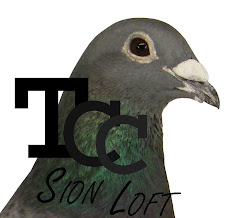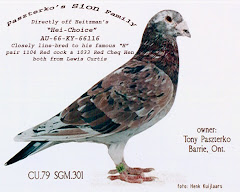Has the current day definition of a "Champion" changed over the years?
In 1945 Mr. Meier clocked his SION Red Chequer Cock '4346' at the 600 mile station on the day. Bred by Charles Heitzman, this Red Chequer Cock flew a total of 12,534 miles in six seasons. This bird flew the 1017 mile station in 1943, won first at the 500 mile station in 1944, was a 600 mile day bird in 1945, and came in second at the 600 mile station in 1946 before being retired to stock in the Heitzman loft.
AU 41 KY 4346
Race Record
1941 - Flown 117
1942 - Flown 100-200-400-500 Miles
1943 - Flown 100-200-300-500-600-1017 Miles
1944 - Flown 200-300-500-400-500-500-1st Dipl. 500 Mile Race
1945 - Flown 100-200-400-300-500-600-300-500-600 Day of Toss
1946 - Flown 100-200-300-500-400-600-500-2nd Dipl. 600
Sire - AU 40 KY 40188 Light Red Chequer from '39238' R.R.C. and '35-76394' Blue from '3251' Blue and '31-1008'B.C.H. from '82030' Silver Cock and '309110' Blue, Bred by Mons, Sion. '39238' from '37-451818' bred by Paul Sion when paired to '3700' R.C.H, daughter of foundation pair, '1104' and '1033' R.C.H. '3251' - 500 day, also 600, son of '1104' and '181876' B.C.H. bred by Paul Sion.
Dam - 'AU 40 KY 40618' D.B.C.H. Bred from two 500 mile day birds. '3105' R.C.C. son of foundation pair '1104' and '1033'. Mother of '40618' is DAILY DOUBLE '3697' D.B.C.H. twice 500 day of toss. Bred from '3106' D.R.C.C. and '3103' D.B.C.Pd hen 600 miles from '693955' and '161106' Bronze, both bred by Mons. Paul Sion. '3106' twice 500 and bred from '1104' and '1033'.
Tony Paszterko's SION family traces back to these same blood lines. Tony's AU 47 OKY 848 R.C.C. was a direct son of the famous France 37 451818 Dark Red Chequer Cock illustrated in Heitzman's SION book.
Photo and information taken from "The Paul Sion Strain" by Chas. Heitzman
TCC Loft - Mike Taylor









